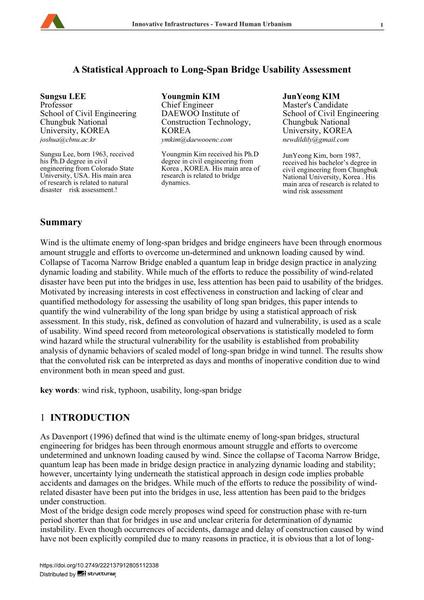A Statistical Approach to Long-Span Bridge Usability Assessment

|
|
|||||||||||
Bibliographic Details
| Author(s): |
Sungsu Lee
Youngmin Kim JunYeong Kim |
||||
|---|---|---|---|---|---|
| Medium: | conference paper | ||||
| Language(s): | English | ||||
| Conference: | 18th IABSE Congress: Innovative Infrastructures – Towards Human Urbanism, Seoul, Korea, 19-21 September 2012 | ||||
| Published in: | IABSE Congress Seoul 2012 | ||||
|
|||||
| Page(s): | 1679-1686 | ||||
| Total no. of pages: | 8 | ||||
| DOI: | 10.2749/222137912805112338 | ||||
| Abstract: |
Wind is the ultimate enemy of long-span bridges and bridge engineers have been through enormous amount struggle and efforts to overcome un-determined and unknown loading caused by wind. Collapse of Tacoma Narrow Bridge enabled a quantum leap in bridge design practice in analyzing dynamic loading and stability. While much of the efforts to reduce the possibility of wind-related disaster have been put into the bridges in use, less attention has been paid to usability of the bridges. Motivated by increasing interests in cost effectiveness in construction and lacking of clear and quantified methodology for assessing the usability of long span bridges, this paper intends to quantify the wind vulnerability of the long span bridge by using a statistical approach of risk assessment. In this study, risk, defined as convolution of hazard and vulnerability, is used as a scale of usability. Wind speed record from meteorological observations is statistically modeled to form wind hazard while the structural vulnerability for the usability is established from probability analysis of dynamic behaviors of scaled model of long-span bridge in wind tunnel. The results show that the convoluted risk can be interpreted as days and months of inoperative condition due to wind environment both in mean speed and gust. |
||||
| Keywords: |
usability long-span bridge typhoon wind risk
|
||||
